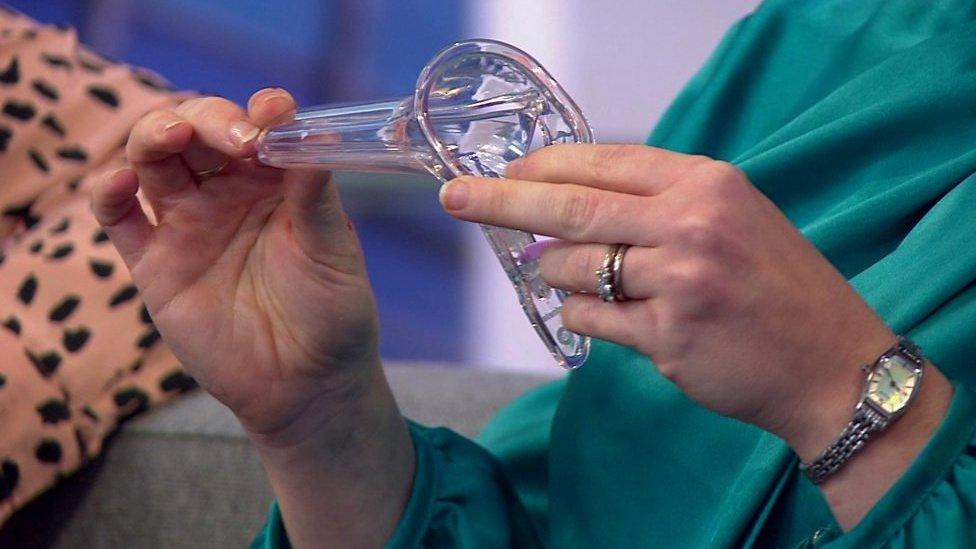Cervical screening: Millions missing smear tests
- Published
What happens during a smear test?
About three million women across England have not had a smear test for at least three-and-a-half years.
GPs are trying to improve take-up rates as figures show up to half of women under 50 in some areas have not had a cervical screening in the recommended time frame.
Screening rates are at their lowest for two decades.
Public Health England said it was "concerned" by the fall.
A further million women aged 50 to 64 have not had a smear test for at least five and a half years.
About 72% of women aged 25 to 64 have had a smear test within the period recommended for their age, according to figures compiled in March 2017.
This is down from 75.4% in 2012.
A total of 220,000 British women are diagnosed with cervical abnormalities each year and there were 854 deaths from cervical cancer in England in 2016.
Cervical screening detects abnormal cells on the entrance to the womb.

'I avoided thinking about it'

Samme Allen says more needs to be done to make sure women know the screening is a "preventative test"
Samme Allen, from Kingston, says the manner of a nurse at a cervical screening she had aged 25 was "the opposite of reassuring".
It was 10 years before she had another one and the result led to a diagnosis of cervical cancer.
She had to undergo "a couple of operations" and has subsequently been given the all clear.
"I worked overseas and regularly moved, so I always seemed to avoid thinking about it," she said.
"I never had any symptoms for cervical cancer, and so didn't feel I needed to go to the doctor."
This continued for a decade until a nurse at a routine health check in 2010 told her she was overdue a screening.
Business consultant Ms Allen said the test should be seen in a similar way to "going to the dentist or opticians".
"Yes, it's uncomfortable and no it's not a pleasant experience, but my story shows how important it really is," she said.
The NHS target is for 80% of women aged 25 to 49 to be tested every three years, external and the same proportion aged 50 to 64 to be screened every five years.
WATCH: Is there scraping in a smear test? The truth about what it really involves , external

Where are screening rates lowest?
London has some of the lowest rates of women screened for cervical cancer. In some boroughs just over half of eligible women under 50 had a test within the past three and a half years.
Official figures from Public Health England (PHE), external, matched to local authority districts, reveal about half of eligible 25 to 49-year-old women registered at GP practices in Westminster, Kensington and Chelsea, Camden and Hammersmith and Fulham had received adequate screening.

Cambridge and Oxford also had rates of 54 and 55%.
In Leicester it was 60%, rising to 61% in Luton and 62% in Manchester, Slough, Haringey and Birmingham.
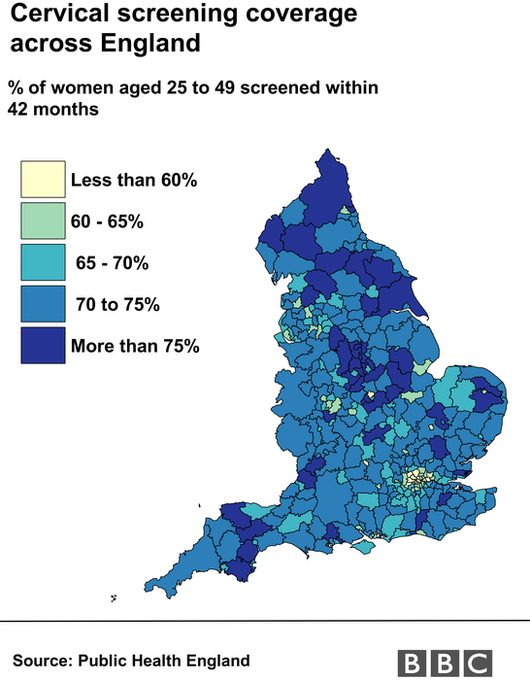

Rushcliffe in Nottinghamshire was at the other end, with 80% of eligible women having had the test in the past three-and-a-half years.
A spokeswoman for Rushcliffe CCG said practices in the Nottinghamshire area deemed not to be achieving screening targets were given extra support.
She said Cancer Research UK had been helping to improve uptake.
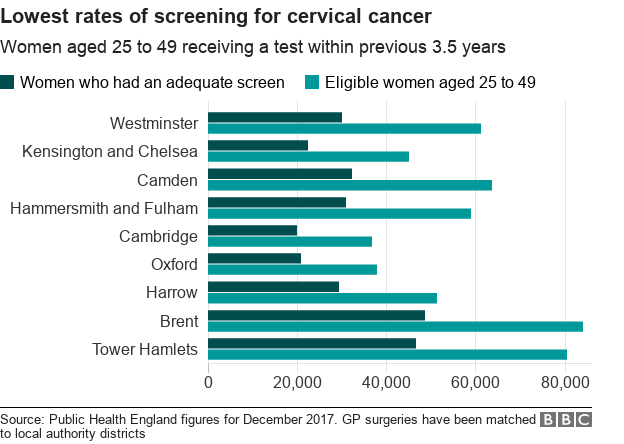

You may also be interested in:

Why have so many women not received a screening?
Experts put it down to embarrassment, a lack of awareness or just putting it off.
A survey of 2,017 women by the charity Jo's Cervical Cancer Trust suggested young women were embarrassed to attend smear tests because of their body shape (35%), the appearance of their vulva (34%) and concerns over smell (38%).
A third said they would not go if they had not waxed or shaved their bikini area.
About 15% said they would miss their smear tests for a gym class or a waxing appointment.
Dr Laura Marlow from University College London conducted research into cervical cancer screenings and said ethnicity also played "an important role".
"We found that women from ethnic minority groups were more likely to be unaware of screening and older women were more likely to have decided not to go," she said.
"Understanding these patterns will help us to decide how interventions might be shaped differently for different types of non-attenders."
However, she added: "I think we have to be careful about saying that ethnicity contributes to the absolute numbers because it is only a part of the picture."
A spokeswoman for clinical commissioning groups (CCGs) in north west London said GPs faced challenges in areas with "language barriers, religious concerns and high levels of deprivation".
Why are screening rates falling?

Former Big Brother contestant Jade Goody is credited with a rise in cervical screening rates following her death in 2009
Cervical screening rates rose following the death of realty TV star Jade Goody, external at the age of 27 in 2009, as her story brought about greater awareness, but the numbers have fallen back since.
Dr Asha Kasliwal, president of the Faculty of Sexual and Reproductive Healthcare, said: "Cervical screening is not a mandated requirement for local authority commissioning. Local authorities under severe budgetary pressure are not including this essential aspect of women's health care in their service specifications.
"GPs have a very positive role to play in increasing uptake by offering opportunistic screening, but primary care is not able to effectively meet the increased demand.
"Screening rates are now at their lowest in two decades and the minimum 80% national target is far from being achieved," she said.
Dr Kasliwal is calling for resources and more funding for cervical screening in primary healthcare, and for it to be included in sexual health services.
What is being done to improve screening rates?
Women in north-west London women are being offered evening and weekend screenings in order to make it more convenient to attend.
Robert Music from Jo's Cancer Trust said there was "no one magic solution" to improve attendance, but the charity was working with GPs to provide drop in surgeries, phone clinics and "engagement with community or faith groups".
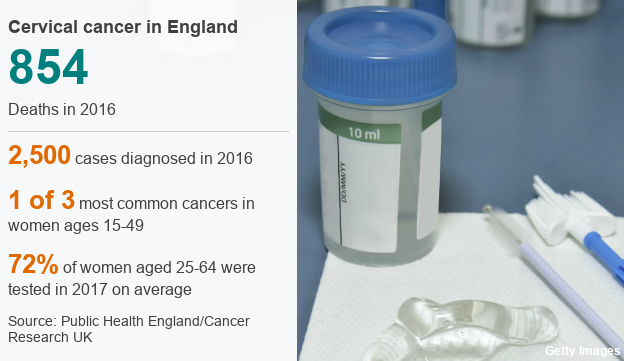
Professor Anne Mackie, PHE's director of screening said: "PHE, alongside charities including Jo's Cervical Cancer Trust, the NHS and local authorities, are concerned about the fall in women taking the test.
"Currently 72% of women have cervical screening and we're working together to ensure that every woman knows what the test is about and to make it easy to attend screening appointments."
- Published22 January 2018

- Published18 September 2018
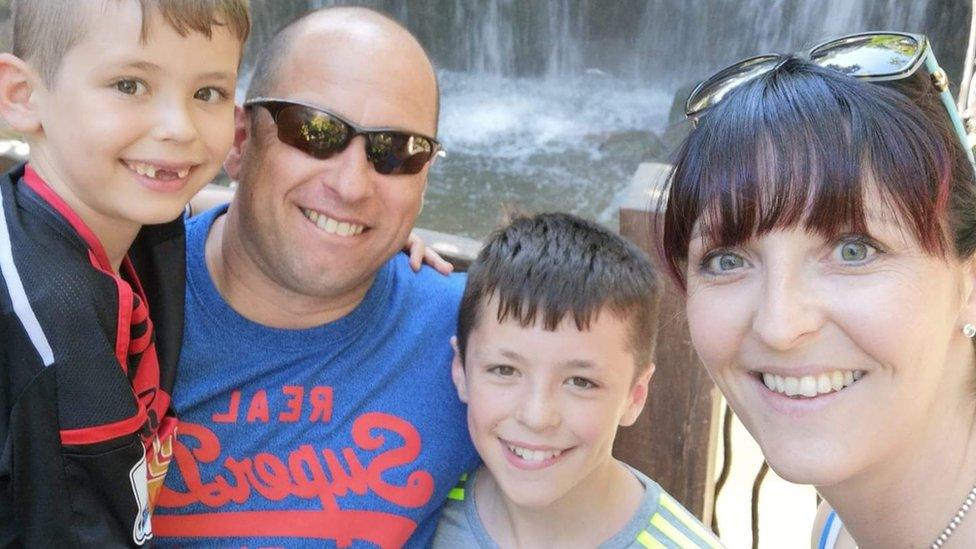
- Published12 September 2018
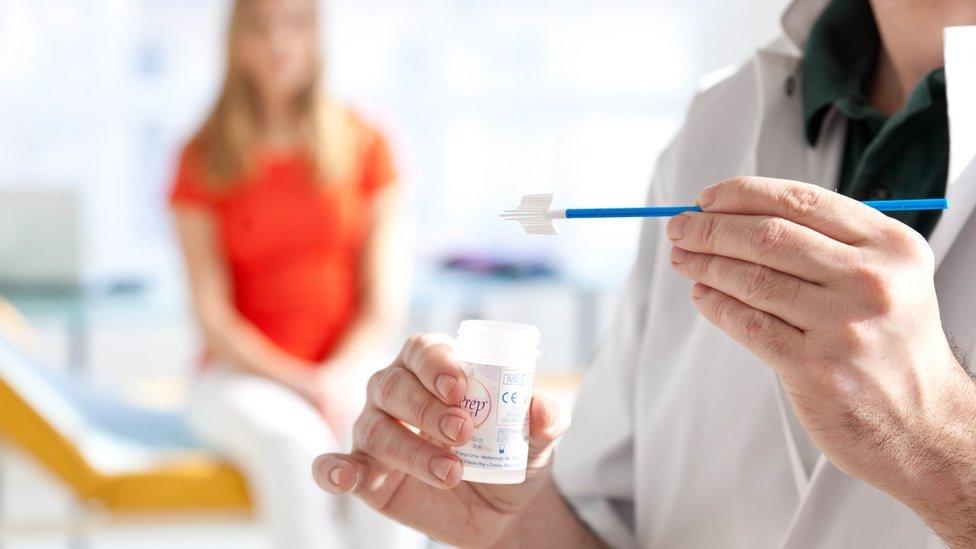
- Published28 February 2018
